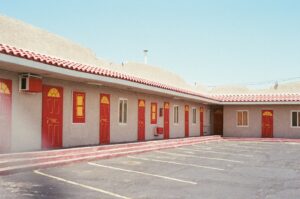Hotel Conversion to Apartments: Why This Trend is Rising
Capitalizing on underutilized hotels and motels, savvy developers are turning these structures into affordable apartments, addressing the dire housing crisis. This exciting trend not only offers a higher return on investment but also revives neighborhoods and responds to the demands of modern city living.
Some of the key factors to consider when exploring a hotel conversion to apartments is the thoughtful transformation of the rooms into livable spaces, ensuring compatibility with local zoning laws and a prime location.
These conversions are reshaping the real estate landscape, breathing new life into existing assets.
Let’s take a closer look….
Join the Passive Investors CircleHotel Conversion Catalysts
Housing Crisis
The high demand for housing, made worse by the ongoing housing crisis, has led to the growing trend of converting underutilized hotels into apartments. The average cost per unit for hotel-to-housing conversions in California is $130,000, compared with $380,000 to $570,000 per unit for new construction, according to the California Department of Housing. This presents a cost-effective solution for developers and city officials looking to tackle the issue of affordable housing.
Converted apartments can provide much-needed relief in regions with particularly severe housing shortages. As hotels are often constructed in prime locations with easy access to amenities and transportation, they offer an attractive option for potential residents looking for affordable and well-located living spaces.
Hospitality Industry Decline
The hospitality industry has experienced a significant decline, partly due to the effects of COVID-19 and long-term changes in consumer preferences. With fewer travelers and lower occupancy rates, many hotel owners have found it increasingly difficult to maintain profitability.
Converting hotels into apartments has become an appealing alternative for property owners in this weakened market. Although a standard multifamily unit generates roughly 2.5 times less revenue per unit than a hotel room, it typically contributes 60% of the revenue to the bottom line, compared to 35% for hotels. This suggests that multifamily conversions can be a more stable investment, particularly during times of uncertainty in the hospitality sector.
Government Support and Incentives
State Programs
Several states have initiated their own state program to convert underutilized hotels and motels into housing, especially for the homeless. California’s governor proposed a budget that would include funding for hotel and motel conversions, creating around 6,000 units at an average cost of just under $130,000 each (source: Multi-Housing News).
Local Governments
City officials and city councils nationwide are also taking steps to support hotel and motel conversions. Some local governments are conducting feasibility studies to assess the viability and potential benefits of converting underutilized commercial properties into affordable housing units.
These studies help policymakers make informed decisions and prioritize funding for such projects. Local support can also include zoning changes, tax incentives, or subsidies to encourage private-sector investment in hotel and motel conversion projects.
Gov. Kathy Hochul of New York City has also expressed an interest in supporting initiatives to alleviate housing shortages and address homelessness in various regions. By collaborating with state and local governments, hotel and motel conversion projects can tap into a broader range of resources and expertise to ensure their success.
Types of Hotel Conversions
Condo Hotel Conversion
Condo hotels are a type of conversion where individual units within the hotel are sold as condominiums. These buildings often retain some hotel-based services to cater to the resident’s needs, combining residential living with hotel amenities. Residents can live permanently or rent out their units for short-term stays, making it a popular choice for apartment units.
This type of conversion is ideal for more upscale and luxury hotel properties, which can attract buyers and investors who appreciate the convenience and amenities a hotel-residence hybrid offers.
Motel Conversions
Motel conversions involve transforming old or underperforming motels into multifamily residential units. Depending on the space and layout, these may be converted into studios, one-bedroom apartments, or even larger units.
Due to the motels’ original design for short-term stays, they usually require some renovation and remodeling to accommodate more long-term housing needs, such as adding kitchens and more living space to each unit.
This option is particularly advantageous in areas with an affordable housing crisis, as it can provide lower-cost housing alternatives for tenants and often utilizes buildings with lower land values.
Older Buildings
The conversion of old hotels into apartments is a viable solution for utilizing outdated properties in prime locations that may not be competitive in the hotel market anymore. These often have historical or architectural significance, and their conversion into multifamily apartments can breathe new life into them while maintaining their charm and character. Adaptive reuse preserves the historical value of the property while addressing modern housing needs, a win-win for communities and developers alike.
Older buildings can be transformed into various housing types, such as affordable housing, luxury apartments, or even mixed-income communities. Depending on local demand and zoning regulations, hotel conversion projects will often require extensive renovation work, including updating plumbing, electrical, and HVAC systems, adding kitchens and laundry facilities, and reconfiguring the interior spaces to accommodate the needs of residents.
Don’t Miss Any Updates. Each week I’ll send you advice on how to reach financial independence with passive income from real estate.
Sign up for my newsletterWhat Is Involved In The Conversion Process?
Building Code Requirements
Building code requirements may vary depending on the location and jurisdiction, so it’s important to consult local government offices and regulatory bodies. Developers must pay close attention to fire safety, earthquake resistance, accessibility, and parking facilities that align with residential building codes.
Renovation Process
The renovation stage in the conversion process can be time-consuming and potentially expensive. Property developers must evaluate the existing structure and determine the extent of necessary alterations to the building layout.
One of the primary challenges is addressing the differences in design and functionality between hotel rooms and residential apartments.
For example, hotel rooms usually have a single room with extra amenities, while apartments typically feature separate cooking, dining, and living spaces. The overall renovation plan must include combining hotel rooms to create larger apartments or adding kitchens to individual units.
From Hotel to Residential Apartments
Once building code requirements and renovations are addressed, developers can transform the hotel into apartments. This includes reconfiguring common spaces to suit a more long-term living arrangement, like incorporating shared amenities like gyms, laundry facilities, and social areas.
Developers must also consider marketing strategies for the newly converted residential apartments. Implementing effective advertising and considering the target demographic is essential to successfully transitioning a hotel property into a thriving residential apartment building.
What About Costs and Financial Comparisons?
Cost of Conversion vs New Construction
Construction costs play a big part in the conversion process. Converting hotels to apartments can be more cost-effective than new construction. As previously mentioned, the average cost per unit for hotel-to-housing conversions in California is $130,000, compared to $380,000 to $570,000 per unit for new construction.
This significant cost difference can make conversions more attractive for developers, especially considering the lower-end rental market. Renovating an existing structure is generally cheaper than building a new one, allowing for higher returns on investment.
Purchase Price and Rates
The cost of capital for a bridge loan for a multifamily conversion can range from 4% to 7% percent with some or no recourse, which is more favorable than a simple hotel repositioning loan that costs 7% to 11%. The rental rates for converted apartments tend to be at the lower end of the market due to the more affordable renovation cost than new construction.
Developers must consider the property’s location, size, and current state to assess whether the conversion is financially viable. In some cases, it may be more cost-effective to invest in new construction rather than converting an existing hotel.
Challenges and Risks
Residential vs Commercial Usage
One of the challenges in converting a hotel into permanent housing is the transition from commercial to residential use. This shift may require the building to conform to different building codes, accessibility requirements, and other regulatory standards that differ from the original hotel structure.
For instance, converting to residential use may trigger accessibility requirements for persons with disabilities that hotels do not currently meet. Additionally, certain floor-to-area ratios might be capped for residential buildings, which can complicate the conversion of larger hotels.
Hotel owners considering conversion should be prepared for a potential overhaul of the building’s infrastructure. They should work with their city council to closely analyze local building codes, zoning regulations, and other pertinent legal requirements to ensure a seamless transition to residential use.
Future Outlook and Market Trends
The hotel industry has been aware of the rising interest in conversion projects and has begun adapting to this trend. Some hotel operators are partnering with developers to diversify their portfolios and ensure the long-term stability of their properties. For example, the Buffalo Grand Hotel is planning to convert 200 of its 484 hotel rooms into apartments.
As more hotel properties are being repurposed for residential use, both developers and the hotel industry need to stay informed about the changing landscape. This will allow them to effectively respond to market demands and make the best business decisions.
Frequently Asked Questions
What are the costs involved in converting a hotel into apartments?
The costs of converting a hotel into apartments can vary greatly depending on factors such as location, existing infrastructure, and regional regulations.
How does the profitability of operating a hotel compare to an apartment complex?
While a standard multifamily unit may generate roughly 2.5 times less revenue per unit than a hotel room, they typically contribute 60% of their revenue to the bottom line, compared to 35% for hotels. This suggests that apartments may be more profitable despite generating lower revenue due to steadier income from annual leases.
Can hotels be converted into affordable housing?
Yes, these conversions offer a creative solution to many regions’ ongoing housing shortage and affordability crisis.
What are the key factors to consider in a hotel-to-residential conversion?
Key factors to consider include the size and layout of hotel rooms, local government regulations and zoning, location, and affordability of the project.
How does the guest experience differ between hotels and apartments?
The guest experience may differ significantly. While hotels typically provide a variety of amenities and services such as housekeeping, room service, and on-site facilities, residential apartments often offer fewer amenities but may provide more personal living spaces. Residents of converted apartments may enjoy the benefits of both hotel-style services and self-contained living arrangements, depending on the specifics of the conversion.







